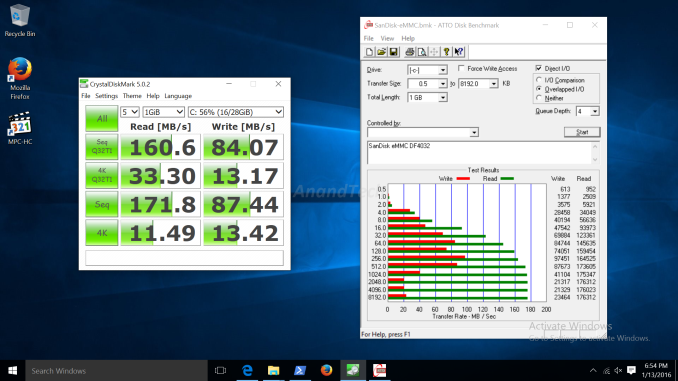The Intel Compute Stick (Cherry Trail) Review
by Ganesh T S on January 14, 2016 8:00 AM EST- Posted in
- Systems
- Intel
- Cherry Trail
- HDMI Stick
- CES 2016
- Compute Stick
Networking and Storage Performance
Networking and storage are two major aspects which influence our experience with any computing system. This section presents results from our evaluation of these aspects in the Intel PPSTK1AW32SC.
Evaluating the capabilities of the primary storage subsystem turned out to be a challenging process. We usually use PCMark 8's storage bench for mini-PCs. However, the lack of enough free space after installing a couple of Windows updates meant that PCMark 8 would consistently crash during the benchmark process. However, we were able to process the benchmark on the Patriot EP series microSDXC card. The results were not any different from what we obtained in the Bay Trail Compute Stick review. That said, in order to get an idea of the eMMC performance, we ran ATTO and CrystalDiskMark on the SanDisk DF4032. A screenshot of the results is presented below.
On the networking side, we restricted ourselves to the evaluation of the WLAN component. Our standard test router is the Netgear R7000 Nighthawk configured with both 2.4 GHz and 5 GHz networks. The router is placed approximately 20 ft. away, separated by a drywall (as in a typical US building). A wired client is connected to the R7000 and serves as one endpoint for iPerf evaluation. The PC under test is made to connect to either the 5 GHz (preferred) or 2.4 GHz SSID and iPerf tests are conducted for both TCP and UDP transfers. It is ensured that the PC under test is the only wireless client for the Netgear R7000. We evaluate total throughput for up to 32 simultaneous TCP connections using iPerf and present the highest number in the graph below.

In the UDP case, we try to transfer data at the highest rate possible for which we get less than 1% packet loss.

The Wi-Fi performance has improved tremendously compared to the Bay Trail Compute Stick. Though we strangely found UDP throughput to be a bit off (lower than the TCP), the performance on the whole was excellent. It solves one of the major pain points associated with the Bay Trail Compute Stick.











80 Comments
View All Comments
zepi - Thursday, January 14, 2016 - link
How about testing the H265 as well? I'm sure people will stumble upon it more and more as everyone wants to save in bandwidth costs.ddriver - Thursday, January 14, 2016 - link
Come on now, would it kill you to put 4 gigs of ram instead? That would significantly improve the usability.utroz - Thursday, January 14, 2016 - link
Probably has something to do with the fact that it has a 32bit version of windows so they skimped on the ram. Or they used 32bit windows because they skimped on the ram.. Either way it was a bad call. 64bit windows and 4GB of Ram or more are a must..nathanddrews - Thursday, January 14, 2016 - link
I think that's intentional in order to push people up into the Core m3 and m5 Compute Sticks.Blibbax - Friday, January 15, 2016 - link
Iirc it's because (if you're an OEM) you can get a cheaper Windows license for a low-end system like this.mkozakewich - Sunday, January 17, 2016 - link
2 GB is usable, at least. Windows takes up about 1 GB after boot, so the devices of 2014-2015 were horrible after the eMMC ran out of spare blocks.andychow - Thursday, January 14, 2016 - link
The cpu only supports max 2 gigs of ram. So 4 gigs is impossible.Samus - Friday, January 15, 2016 - link
It's also windows licensing issue. Until basically get windows 10 for free on these devices if they ship with <32 GB NAND and 2 GB RAM.Teknobug - Saturday, January 16, 2016 - link
The X5 Z8300 is a 64bit processor, just like Samus said, devices with 32GB storage and 2GB or less memory gets free Windows license.ddriver - Sunday, January 17, 2016 - link
So they crippled that poor product so it can get free spyware/spamware with it :)